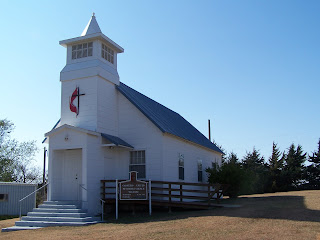Bentz Lewis, with Garden City Coop, looks around the Amy Baptist Church sanctuary.
The Amy Baptist Church is in the shadows of the Garden City Coop.
Amy Baptist Church before it is razed. It sits on K96 west of Dighton.
An old attendance chart is part of the remains littering the church basement. Below, the school closed around 1980.

The town located just west of Dighton on K-96 once had a lumberyard and a general store. The town even had a band - complete with uniforms - and a bandstand. "It had activity," said Pat Herndon, who owns The Old Bank Gallery in the nearby county seat town of Dighton. "But it never had a big population." Amy started back in the late 1800s as Ellen - a stop established by the railroad, said Joel Herndon, Pat's son, who also serves on the Lane County Historical Society board. However, it wasn't until 1906 that the town began to thrive, and the town was renamed Amy, Pat Herndon said. Nolan Yates, who started the post office that year, applied for a permit with the U.S. Postal Service, but his request was denied because Ellen was already a name of another town in eastern Kansas. Not knowing what to name his community, Yates picked names of local teenaged girls and submitted them to the postal service. An official there picked Amy, after 16-year-old Amy Bruner. Herndon said her husband's grandfather, John Herndon, started the lumberyard around that same time as well. A grocery also opened in 1906, according to an old advertisement sign salvaged from the store that now hangs in an area farmer's work shed. It was during this time the town prospered, Pat Herndon said. With nothing more than a horse-drawn buggy to get families from place to place, residents often traveled to the nearest town for social gatherings, such as playing baseball or attending a concert. There were children's games and even a small merry-go-round with an organ music box - the riders pumping the ride to move - similar to an old-style railroad handcar. Those are just a few of the stories that former residents have passed down generation to generation, Herndon said. She herself moved to Amy in 1961 after marrying her husband, Walter. The couple lived there until 2002, when they moved into Dighton. It is also where they attended church for a number of years, she and her husband serving as youth sponsors in the 1960s.
























